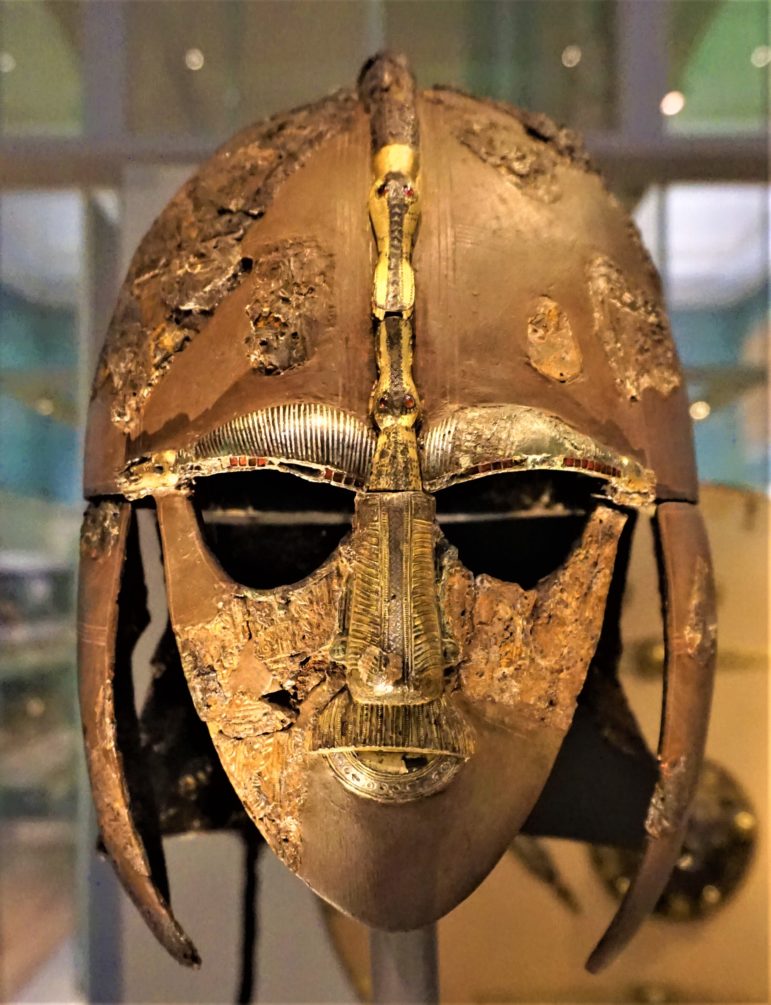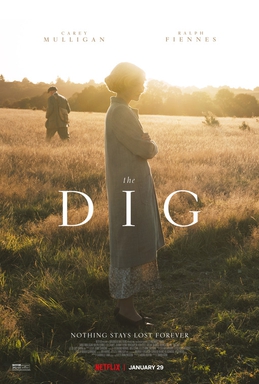SUFFOLK, England – At the end of January the film, “The Dig,” starring Ralph Fiennes and Cary Mulligan, is due to be released on Netflix. The film is based around the discovery of the ship burial at Sutton Hoo in Suffolk, in England. What relevance does this have to British pagans now? In order to find out, we did some digging of our own.
In 1939, amateur archaeologist Basil Brown, played by Fiennes, undertook some investigation in a field belonging to a woman named Edith Pretty (played as a somewhat younger version by Mulligan).
Pretty had an intuition that something was buried on her property and she was right. Brown subsequently uncovered something that turned out to be one of the most significant burials in English history.
Working with a team, Brown discovered the structure of a large ship, which is likely to have been dragged up from the river Deben, and many items within, which were remarkable: gold dress accessories ornamented with Sri Lankan garnets, Byzantine silver, drinking vessels, and a now-famous helmet/mask.

Sutton Hoo helmet – Image credit: Joyofmuseums – CC BY-SA 4.0
The one thing that they did not find was a body. There was a human-shaped space at the center of the burial site but experts are confident that this was not simply a cenotaph, but an actual burial, since there are traces of phosphates in the soil indicative of the presence of a corpse.
Those findings suggest that the body had succumbed to natural causes of decay. However, others point out that no shroud ties or bodily adornments have been found, which one might expect if the body had simply decomposed.
The boat itself is 27 meters in length and had been an actual sea-going ship, not just a representation of one. It is also not the only burial in the area. People of high status were buried in mounds in this part of the country and there are a number of other mound burials in the area surrounding Sutton Hoo.
Sue Brunning, the Curator of Early Medieval European Collections at the British Museum, speaks about the significance of Brown’s find on the museum’s website.
“It’s this effort, coupled with the quality and the quantity of the grave goods from all over the known world at that time, that has made people think that an Anglo-Saxon king may have been buried here. We can’t name that king for certain, but a popular candidate is Rædwald, who ruled the kingdom of East Anglia around this time in the early seventh century. He may have held power over neighbouring kingdoms too, which may have earned him a good send off.”
She added, “…the 1939 excavation carried out by Basil Brown and the other archaeologists was done so well that its results went on to transform our understanding of this time in history, and the lives and beliefs of the people who lived then.”
We asked some of the British and Irish pagan community for their views:
Gavin Bone told us, “It’s likely it’s the burial site for a Danish rather than an Anglo-Saxon king. The finds do show just how much trading was going on before 1066. There [are] even Arabic/North African items.”
If the site is the burial chamber for Rædwald, then the king maintained a Pagan temple in the region although, ironically, he was the first East Angle king to convert to Christianity: he did so at Æthelberht’s court at some point before 605 AD.
But the site is not proven to have been Rædwald’s tomb, as Gavin Bone points out above, there have been suggestions that it belongs to a Danish king, and due to similarities between finds at Sutton Hoo and those in Swedish sites, some commentators have also hypothesized that the inhabitant may have been of Swedish origins.
However, as pointed out on the British Museum’s website, the contents of the ship burial come from many different regions and this is indeed an indication of the level of trade at this time.

Sutton Hoo burial mounds with Pretty’s house in the distance – Image credit: Tim Marchant, CC BY-SA 2.0
Shamanic practitioner Karen Kelly noted that “The actual finds reveal a society with as many links to Merovingian Gaul as to Scandinavia.”
Jez Green, also a member of the Pagan community, said, “I love how it shows the richness, diversity, and connections of Anglo-Saxon England.”
The star of “The Dig,” Ralph Fiennes, is himself no stranger to archaeology. Much of his film profits have literally been sunk into a hole in the ground in the form of his adopted brother Mike Emery’s dig near Chester. The Poulton Research Project undertook the dig in the early 2000s to uncover a Roman villa and currently works to introduce students to field archaeology and other aspects of the discipline.
Pagans interested in the archaeological heritage of the British Isles may find much of interest in “The Dig,” and may be moved to look more closely into the background of Sutton Hoo.
The finds themselves can be visited in the British Museum (when it re-opens after lockdown) and you can also visit the National Trust site itself, but Pagans might be wondering what kind of Pagan Rædwald was, prior to his conversion (and after it, since he seems not to have abandoned his old god). However, we do not know a great deal about him.
Historian Dr. Sam Newton comments that, “Our knowledge of [Rædwald] and the early seventh century is dependent almost entirely on Bede’s early eighth-century Historia Ecclesiastica. Bede writes so well that it is easy to forget that his is a selective, Roman Christian and Northumbrian English view of history.”
Bede condemns Rædwald for setting up an altar to his new god alongside his old ones. It may have been that the king’s conversion was for reasons of political expediency rather than theological conviction.
Who might this older god have been? Rædwald himself was descended from the Wuffinga family, who claimed direct descent from Woden, so historians think that the most likely candidate for Rædwald’s worship would indeed have been Woden. It would be unusual now to find twin altars to Woden and to Christ – but this ancient king may have seen it as an ideal community to bring his community together in an act of syncretic worship.
The Wild Hunt is not responsible for links to external content.
To join a conversation on this post:
Visit our The Wild Hunt subreddit! Point your favorite browser to https://www.reddit.com/r/The_Wild_Hunt_News/, then click “JOIN”. Make sure to click the bell, too, to be notified of new articles posted to our subreddit.
